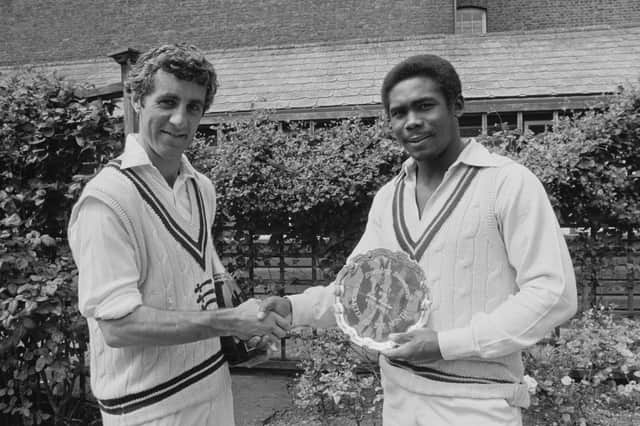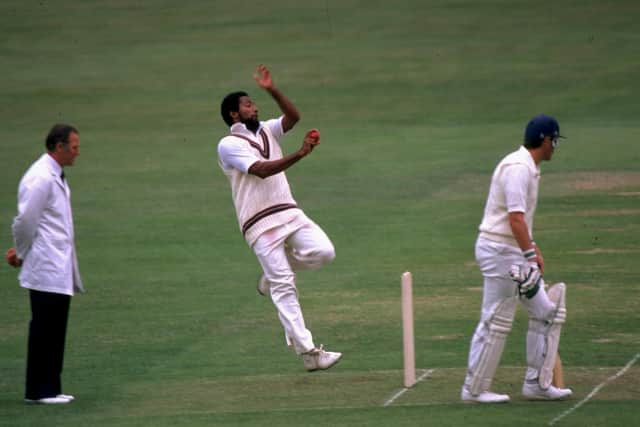How two Hampshire legends made England captain Tony Greig eat his ‘grovel' word’ in a lethally hot summer


It was a side containing two Hampshire legends and some of the greatest names ever to play on the biggest stage of them all.
This week, Hampshire’s Ageas Bowl has been the setting for the first of a three-Test series between England and the West Indies - all games played behind closed doors in a bio-secure environment.
Advertisement
Hide AdAdvertisement
Hide AdEvery time the Windies visit these shores, it brings back memories of a golden era in Caribbean cricket. Great memories for the Windies, but very painful ones for English players - literally, at times - and supporters.


There was the 1984 ‘blackwash’ tour when Clive Lloyd’s tourists won all five Tests against David Gower’s England. It was a scoreline repeated when England visited the Windies in early 1986.
Malcolm Marshall, Joel Garner, Patrick Patterson, Colin Croft, Curtly Ambrose, Courtney Walsh - just some of the fearsome production line of fast bowlers the Windies could call on to rip through English batting orders in a halcyon era.
Patterson splattered Mike Gatting’s nose in 1986 - fragments of Gatting’s bone were found embedded in the ball - while a Marshall bouncer felled debutant opener Andy Lloyd two years earlier. In the same series, a rising delivery from Winston Davis broke Hampshire batsman Paul Terry’s arm in only his second Test. Neither Lloyd or Terry ever played for England again.
Advertisement
Hide AdAdvertisement
Hide AdNone of those bowlers, though, were part of the legendary West Indies side which toured England in the lethally hot summer of 1976.
Forty four years later, in the week the latest series between the teams got underway, it is worth recalling the incredible feats of a remarkable team.
Led by Lloyd, the Windies played their first game of the 1976 tour on May 8. Exactly five months later, on September 8, they played their last.
The Windies’ fixture list contained three-day games against all 17 first class counties, plus three-day games against the Minor Counties and a combined Oxford & Cambridge University XI. There was also space in a crowded programme for a two-day encounter with Ireland in Dublin.
Advertisement
Hide AdAdvertisement
Hide AdThe tour kicked off with a one-day game against the Duchess of Norfolk XI in Arundel and finished with another one-dayer against a Northern Leagues XI at Harrogate.
The final game was preceded by a three-day game against a Tom Pearce XI and a one-day match against the same opponents.
In all, Lloyd’s tourists played 35 games, including five Tests and three ODIs against England, in those five months.
They only lost two - a three-day game against Middlesex at Lord’s and another three-day game against Tom Pearce’s XI (who included eight Middlesex players).
Advertisement
Hide AdAdvertisement
Hide AdSix games were drawn - two Tests and four three-dayers against county opposition.
Every other game - all 27 of them - were won. Most of them convincingly.
Compare that schedule to the Windies’ last tour of England in 2017, where they played just 12 games. Four of those were against county opposition, plus three Tests, five ODIs and a solitary T20 international.
Times have certainly changed.
Two men who had helped Hampshire win their second (and last) Championship three years earlier were mainstays of the side.
Advertisement
Hide AdAdvertisement
Hide AdOpening bat Gordon Greenidge lashed 1,952 first class runs in 20 matches - including eight centuries - at 55.77.
Fast bowler Andy Roberts claimed 28 wickets in five Tests - ending the series as the joint-highest wicket-taker alongside team-mate Michael Holding.
The legendary Viv Richards struck 1,724 runs in 16 first class games at 71.83 - including 829 in just four Tests at 118.42.
Larry Gomes (1,393), Lloyd (1,363), Collis King (1,320) and Roy Fredericks (1,250) also compiled over 1,000 first class runs, and Lawrence Rowe hit 971.
Advertisement
Hide AdAdvertisement
Hide AdRoberts was one of six tourists to bag over 50 first class wickets - a list topped by two men not as well known as some of their more illustrious team-mates, Albert Padmore (59) and Raphick Jumadeen (58).
There have been some truly great touring sides to visit England - Sir Don Bradman’s 1948 Australians, Lloyd’s 1984 vintage - but it is hard to argue that the 1976 West Indians were not the greatest of the great.
But for much of the preceding six months, the Windies struggled. Touring Australia in the winter of 1975/76 they were blitzed 5-1 - Aussie pace duo Dennis Lillee and Jeff Thomson doing much of the damage.
That was bad enough, but in the spring of 1976 came a pivotal moment that was to change the course of cricket history.
Advertisement
Hide AdAdvertisement
Hide AdSetting India over 400 to win in Trinidad, Lloyd was furious that his attack - including three spinners - let the tourists triumph by four wickets.
Padmore and Jumadeen bowled 87 overs between them in the second innings and took just two wickets. Imtiaz Ali, in his only Test, was wicket-less in 17 overs.
After that humiliation, Lloyd decided that his side’s best hope of winning Test matches lay with his battery of fast bowlers.
Four were picked for the deciding Test in Jamaica, an infamous encounter where Indian captain Sunil Gavaskar protested about what he saw as the hosts’ intimidating fast bowling.
Advertisement
Hide AdAdvertisement
Hide AdRemarkably, five Indian players were recorded as ‘absent hurt’ in their second innings, gifting the Windies a 10-wicket victory.
Two had been forced to retire hurt in the first innings and another sustained a broken finger, with Gavaskar unwilling to let his tailenders face the likes of Michael Holding and Wayne Daniel.
A few weeks later the Windies touched down on English soil determined that a virtual non-stop fast bowling attack was the way forward.
So it proved to be, not only on that tour but for the next 20 years or so. England would play the West Indies in 29 Tests between 1976 and 1988 inclusive. They would fail to win a single one, losing 20 and drawing nine.
Advertisement
Hide AdAdvertisement
Hide AdThe 1976 series is well remembered for what happened on the field and wonderful performances from Richards, Greenidge, Holding and Roberts.
Off the field, a television interview given by England captain Tony Greig has also gone down in cricketing folklore.
Before the series began, he said: ‘You must remember that the West Indians, these guys, if they get on top are magnificent cricketers. But if they're down, they grovel, and I intend, with the help of Closey (veteran Brian Close) and a few others, to make them grovel.’
It was a good job for Greig that Twitter and 24-hour rolling news didn’t exist back then!
Advertisement
Hide AdAdvertisement
Hide AdThe outcry was immediate - the word ‘grovel’ had sinister connotations for West Indians, many of whom had slave ancestry. In addition, apartheid was a huge issue of the day, so a white South African using the word ‘grovel’ only poured more fuel on the flames.
The scene was set before a ball had even been bowled …
England drew the first two Tests, despite Roberts taking 10 wickets in the second match at Lord’s.
But Greenidge scored a century in each innings - becoming only the second West Indian ever to achieve such a feat in a Test against England - as the hosts were crushed by 425 runs in the third match at Old Trafford.
Greenidge first scored 134 out of a Windies total of only 211 - only two other players reached double figures. The Hampshire player scored 63.5 per cent of his team’s total — at that point the second-highest in history after Charles Bannerman’s 67.3 per cent in the very first Test.
Advertisement
Hide AdAdvertisement
Hide AdHolding (5-17) and Roberts (3-22) then skittled England out for just 71.
Greenidge (101) and Richards (135) piled on the misery as the tourists declared on 411-5 - setting England an unlikely 552 to win.
There followed a session which no-one who witnessed it is ever likely to forget.
England openers Close and John Edrich - amazingly, 45 and 39 years old respectively - were pounded for 75 minutes of the most brutal displays of fast bowling ever seen.
Advertisement
Hide AdAdvertisement
Hide AdWisden - the cricketing bible - described the bowling of Holding, Roberts and Wayne Daniel as ‘frequently too wild and hostile to be acceptable’ against batsmen who, amazingly, weren’t wearing a helmet.
Close was struck on the body numerous times, and Holding was eventually warned by umpire Bill Alley for intimidatory bowling.
The Windies only managed to bowl 14 overs in 75 minutes - Holding delivered seven successive maidens - and England managed 21 without loss off them (including 10 extras). For all his bravery, Close had scored just a single.
Neither Close or Edrich would play for England again.
Greenidge compiled his third century in as many innings in the fourth Test at Headingley, a game the tourists won by 55 runs.
Advertisement
Hide AdAdvertisement
Hide AdEngland managed to dismiss Greenidge for a duck in the first innings of the final Test at The Oval.
That was the good news - the bad was that Richards hit an imperious 291 (at the time the third highest in his country’s Test history) as the Windies rattled up 687-8 declared on a pitch that was virtually devoid of grass in some areas due to the heatwave. The Windies had only ever scored more in a Test innings once.
After England had replied with 435 (Holding 8-92), openers Greenidge (85no) and Roy Fredericks (86no) belted 182 in 32 overs - a phenomenal scoring rate in Test cricket in that era.
That left England 434 to win, but they could only manage 203 as Holding bagged six more wickets to take his match figures to 14-149 - still the best in West Indies Test history.
Advertisement
Hide AdAdvertisement
Hide AdFor the second time in the game, Holding clean bowled Greig cheaply - a first innings 12 followed by a second innings single.
The sight of Greig’s stumps being rearranged left a lasting impression on an unforgettable series.
Who, come the end of the series, was grovelling now?